Townhomes vs Houses: Key Differences Explained


Intro
As the landscape of homeownership continues to evolve, understanding the nuances between different types of residential properties becomes paramount. Townhomes and traditional houses are two popular choices, each offering distinct advantages and challenges. This analysis delves into the intricacies of both options, providing insight into their architectural styles, living spaces, maintenance requirements, and financial implications.
By fully grasping the characteristics of each structure, prospective homebuyers and architecture enthusiasts can make more informed decisions that align with their lifestyles and financial aspirations. In this exploration, we aim to bring clarity to key considerations, including ownership options and community dynamics.
Featured Homes
Architectural Styles
The architectural designs of townhomes and traditional houses often reflect different lifestyles and preferences. Townhomes are typically characterized by a row-like structure, sharing walls with neighboring units. This design not only maximizes limited space in urban areas but also fosters a unique sense of community. Common styles include contemporary, traditional, and modern, allowing for an eclectic mix that caters to diverse tastes.
Conversely, traditional houses offer a broader variety in terms of design. From colonial to ranch-style, these homes provide more flexibility in layout and aesthetics. They often stand alone, allowing for greater privacy and personal expression through exterior features like gardens or patios.
Unique Design Elements
In townhomes, the interior spaces might be more compact but are often designed for efficient use. Features such as open floor plans and multi-level layouts help maximize functionality while also providing a modern living experience. Many townhomes include shared amenities like parks, pools, or common gathering spaces, adding additional value to the community.
On the other hand, traditional houses boast unique design elements that can cater to customization. Homebuyers have the option to personalize their properties, whether through architectural details like bay windows or expansive landscaping. This individuality often appeals to families seeking to imprint their mark on their home environment.
Incredible Locations
Geographic Highlights
Both townhomes and traditional houses find their place in diverse geographic contexts. Townhomes are often nestled in urban centers, making them ideal for those seeking accessibility to city life. This proximity to jobs, restaurants, and cultural attractions enhances their appeal. Areas like downtown districts or revitalized neighborhoods suit the townhome model, attracting residents who value convenience.
Traditional houses are located in varied settings, from suburban developments to rural landscapes. This flexibility allows for an array of lifestyles, whether one prefers the small-town charm or the vibrancy of suburbia. The location often shapes not just the aesthetic but also the living experience.
Cultural Significance
The cultural backdrop of both housing types plays a crucial role in their desirability. Townhomes often cultivate a sense of community given their close-knit nature. Residents may engage more with their neighbors through community events, which can create a supportive environment. Conversely, traditional houses provide a space for families to grow, often allowing for a deeper connection to the neighborhood.
As the analysis progresses, deeper insights into maintenance, financial ramifications, and other factors will further illuminate these residential choices. Each option has its merits and challenges, making an informed decision essential for prospective buyers.
Prolusion
The decision between townhomes and traditional houses represents a significant consideration for potential homeowners. This choice goes beyond mere aesthetics, delving into aspects that shape the living experience. Understanding the distinctions between these two types of residences can benefit buyers in various ways.
Buying a home is not only a financial commitment but also links to lifestyle preferences and social dynamics. Townhomes often appeal to those seeking community comforts alongside personal space. Conversely, traditional houses may resonate with individuals who desire independence and larger yards. This article aims to clarify these diverse housing options, allowing readers to assess which best suits their needs and aspirations.
Attention will be given to architecture, living space, maintenance responsibilities, and financial implications. Each aspect carries weight when deciding on a home, influencing not just present satisfaction but future investments as well. This exploration will help real estate enthusiasts and potential buyers navigate their choices with confidence, facilitating informed decisions in a complex housing market.
Ultimately, the comparative analysis offered here aims to equip readers with valuable insights, ensuring they can make choices that align with their lifestyle and financial goals. By delving deeply into the nuances of townhomes and houses, we can foster a better understanding of the residential landscape.
Defining Townhomes and Houses
In the realm of real estate, understanding the distinctions between townhomes and traditional houses is crucial for potential buyers. This section unveils the fundamental concepts underpinning these two types of dwellings. As individuals ponder whether to invest in a townhome or a traditional house, it becomes imperative to recognize the specific elements, benefits, and considerations associated with each option.
Elements of a Townhome
Townhomes are typically characterized by their shared walls with one or more adjacent units. This design allows for efficient use of land and can lead to more affordable housing options in urban areas. A significant feature of townhomes is the concept of community living, which fosters a sense of belonging among residents. Common elements of a townhome include:
- Multi-level design: Many townhomes offer multiple stories, providing distinct living spaces that can accommodate families.
- Private outdoor space: Although often smaller than what traditional houses offer, townhomes frequently come with a yard or patio for personal use.
- Homeowner association (HOA) management: Most townhome communities have an HOA, which oversees upkeep and community rules. This can relieve homeowners from certain maintenance tasks.
It is important to note that while townhomes can present a more compact living situation, they provide an opportunity for community engagement and shared amenities.
Characteristics of a Traditional House
In contrast, traditional houses typically stand independently, offering greater privacy and more expansive outdoor spaces. These homes often feature:
- Individual properties: Traditional houses generally occupy their own lot, giving homeowners complete control over the parcel of land.
- Varied architectural styles: The design of traditional houses spans a range of styles, from colonial to modern, catering to diverse aesthetic preferences.
- Increased living space: A detached house usually provides more room in both the home and yard, accommodating larger families more comfortably.
While owning a traditional house requires individual maintenance responsibilities, it also presents the advantage of autonomy, allowing homeowners to make personalized modifications or repairs without necessitating approval from an HOA.
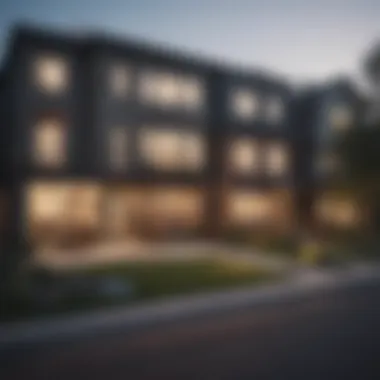
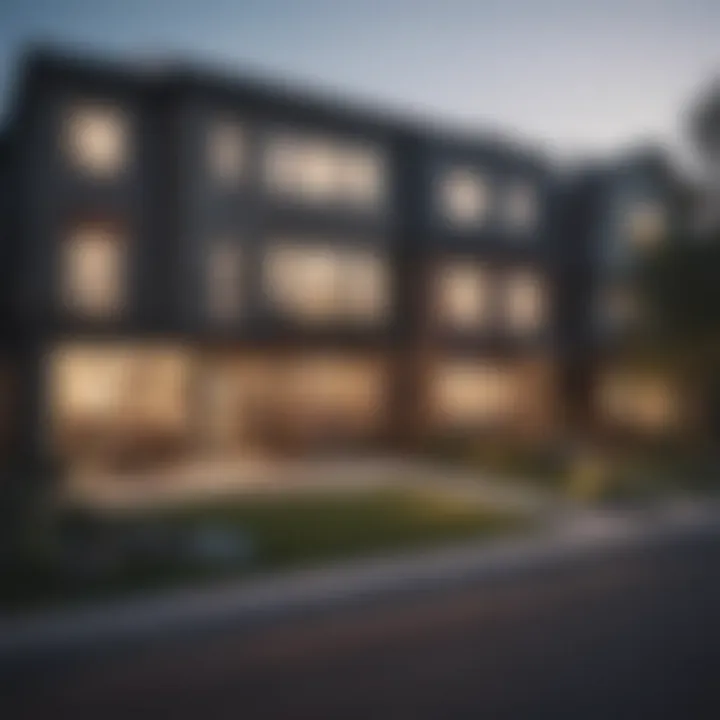
Understanding these core differences helps potential buyers to align their housing choice with their lifestyle preferences and budgetary constraints.
Thus, the choice between a townhome and a traditional house entails evaluating individual needs and priorities, establishing a clearer direction for prospective homeownership.
Architectural Design Differences
Architectural design plays a significant role when comparing townhomes and houses. It not only reflects personal choice but also dictates functionality, aesthetic appeal, and even future resale value. Understanding these design differences is crucial for any potential homeowner. Each style has unique features that cater to various lifestyle preferences and needs.
Townhome Design Features
Townhomes typically showcase a row-style configuration, combining multiple units into one structure. This design often maximizes the available land and encourages a cohesive community atmosphere.
Key features of townhome design include:
- Multi-story layouts: Most townhomes consist of two or more floors. This vertical space utilization often provides more living area without requiring a larger footprint.
- Shared walls: Townhomes have adjoining walls with neighboring units. This reduces external maintenance but can affect noise levels within the home.
- Minimal yard space: Many townhomes have small yards or patio spaces, which can appeal to those who prefer low-maintenance gardening.
- Architectural uniformity: The design may follow a specific style within a community, creating a pleasing aesthetic but limiting personalization.
House Design Trends
Traditional houses, on the other hand, offer various designs. Detached houses can reflect individual tastes more freely compared to townhomes. They generally provide larger yards and a distinct architectural character.
Trending characteristics of traditional house design include:
- Single and multi-story options: Houses can vary greatly in height and layout, offering a choice between sprawling single-story ranch styles or traditional two-story homes.
- Customizable facades: Homeowners often have the liberty to choose their exterior finishes, from brick to vinyl siding, reflecting personal style.
- Generous outdoor spaces: Larger yards allow for different uses like entertainment areas, gardens, or children’s play areas. This aspect could enhance enjoyment for families.
- Diverse architectural styles: Various aesthetics exist, from colonial to modern, providing options depending on individual preferences.
The differences in architectural design between townhomes and houses reflect not just functional choices, but also lifestyle attitudes and community integration.
Selecting between a townhome and a house requires a careful assessment of these design elements. Each offers distinct advantages and considerations that can greatly impact living quality and satisfaction.
Living Space and Layout Considerations
Living space and layout carry great significance when comparing townhomes and houses. These elements directly impact the comfort and utility of each living environment. Understanding the distinctions in spatial organization can help prospective buyers to make informed choices, especially in urban settings where efficient use of space often equates to higher quality of life.
For many, the way a home is laid out can determine how well it suits their daily activities. In townhomes, layouts are often designed to maximize vertical space, integrating multiple living levels. This can offer a compact yet roomy feeling. Houses, in contrast, can vary significantly in layout, often spanning wider spaces horizontally. People looking for spacious living might favor traditional homes.
Space Efficiency in Townhomes
Townhomes generally excel in space efficiency. They are typically narrower and taller than traditional houses. This verticality enables them to offer multiple floors without occupying extensive land area. The clever use of space can include features like open-concept living areas, which foster interaction and accessibility. Storage solutions often utilize under-stair areas and vertical shelving, making the most of every inch.
Additionally, communities featuring townhomes may also incorporate shared amenities. These can include parks or recreational spaces, fostering a communal lifestyle while balancing private living quarters. Thus, individuals who value proximity to neighbors without sacrificing personal privacy may find townhomes appealing.
Layout Variations in Houses
Houses present a wider variety of layout options. With designs that can be sprawling ranch styles to compact bungalows, buyers have numerous configurations to explore. Traditional houses can have segmented spaces, often including separate dining rooms, living rooms, and possibly formal entryways. This can create distinct areas for different activities, which may appeal to families desiring separation between social and personal spaces.
Moreover, houses create opportunities for customization. Homeowners can alter floor plans, expand rooms, or incorporate personal touches. This can be particularly attractive for those who wish to tailor their living environment entirely according to their lifestyle. The result can be a unique sanctuary that meets the specific needs and preferences of the inhabitants.
"The layout of a home is as crucial as its location; both play a significant role in lifestyle satisfaction."
In summary, both townhomes and houses offer unique advantages in terms of living space and layout. Townhomes are designed with efficiency and accessibility in mind, while houses offer variety and the potential for personalization. The choice between the two will largely depend on individual priorities, such as community involvement versus private space. Understanding these distinctions can aid in making a well-rounded decision.
Community and Lifestyle Dynamics
Understanding the dynamics of community and lifestyle is essential to evaluating the differences between townhomes and traditional houses. The choice of residence influences not only an individual's daily life but also how they interact with their surroundings. The structure of the community can enhance personal well-being while shaping social interactions. Therefore, recognizing the specific elements that characterize townhome living versus that of traditional houses can aid potential buyers in selecting a home that aligns with their lifestyle and values.
Community Aspects of Townhome Living
Townhome living often emphasizes community and connection. Residents typically share walls with neighbors, which can foster a sense of closeness. Many townhome developments are designed with shared spaces, such as parks, pools, or community centers. This layout encourages neighborly interactions and creates opportunities for social gatherings.
Additionally, townhome associations often maintain the exterior and communal amenities, allowing residents more leisure time.
Benefits of Community in Townhome Living:
- Social Interaction: Increased opportunities to engage with neighbors.
- Maintenance Support: Shared responsibility of upkeep through homeowners associations.
- Amenities Access: Often includes shared recreational facilities.
However, living in close quarters can have downsides. Noise can be an issue, and privacy may not be as pronounced compared to detached houses. Residents must also adhere to community guidelines that might limit personal expression in home renovations or landscaping.
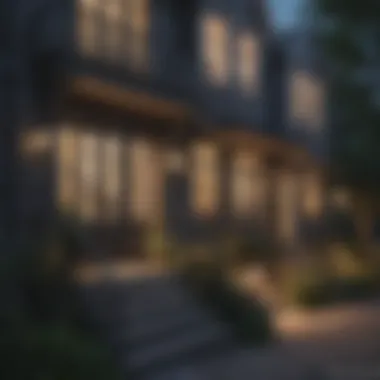
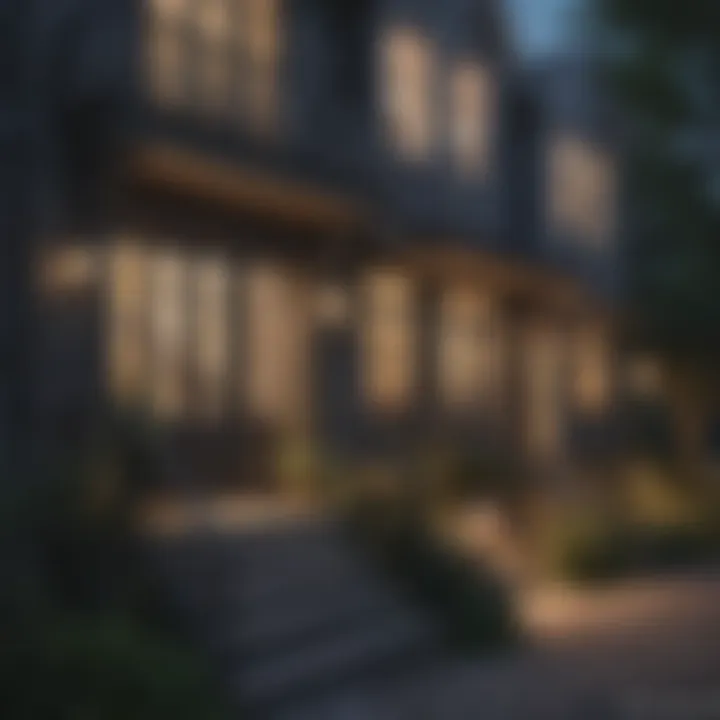
Neighborhood Characteristics of Houses
In contrast, traditional houses are often set in neighborhoods where individualism and personal space are prioritized. Each piece of property typically features a larger plot of land, which encourages privacy and personal landscaping choices. This may lead to increased satisfaction for those who value solitude and the freedom to modify their homes without communal oversight.
Key Characteristics of Neighborhoods with Houses:
- Variety of Styles: Detached houses often come in numerous architectural styles reflecting the owners’ tastes.
- Privacy: More space between homes provides a buffer against noise and distractions.
- Land Ownership: Homeowners usually own the land, allowing for full autonomy in renovations and landscaping.
Nevertheless, traditional houses may also come with drawbacks. Neighborhoods can be geographically isolated, potentially limiting social engagement. Also, maintaining the property, both outside and inside, falls solely on the homeowner's shoulders, which can be a significant time and financial commitment.
"The choice between townhome and house living greatly depends on individual priorities regarding community engagement, privacy, and structural maintenance."
In summary, the community and lifestyle dynamics reveal distinct priorities between townhome living and traditional houses. These differences can significantly impact the experience of homeownership and day-to-day life.
Ownership and Investment Implications
The choice between townhomes and traditional houses carries significant ownership and investment implications. Understanding these dynamics can guide potential homebuyers in making informed decisions that align with their financial objectives and lifestyle preferences. The factors influencing ownership vary widely between these two types of residential structures, as the inherent characteristics of each shape the overall investment experience.
Townhomes often offer a more affordable entry point into homeownership, especially in urban settings where traditional single-family houses are typically more expensive. The price point is a critical consideration for many buyers, particularly first-time homeowners. However, the lower upfront cost may come with trade-offs in terms of space and privacy.
Moreover, the resale value of townhomes can be influenced by community management. In many cases, townhome communities are governed by homeowners’ associations (HOAs) that dictate rules and the overall aesthetic of the community. While this oversight can enhance property values through maintained common spaces, it can also restrict personal modifications, complicating resale opportunities.
Conversely, traditional houses usually offer greater flexibility in ownership. Homeowners have the liberty to alter their property according to personal tastes without needing approval, which can be appealing for those looking to customize their living space. The higher initial investment in a traditional house often correlates with stronger equity growth over time, assuming the property is well-located.
In summary, the ownership structure and investment potential between townhomes and traditional houses present distinct advantages and challenges. The choice between them involves considering personal lifestyle needs along with the long-term financial implications of each option.
Financial Aspects of Townhome Ownership
When assessing townhome ownership, several financial aspects come into play that prospective buyers should carefully analyze. The initial purchase price is typically lower than that of standalone houses, making townhomes an attractive choice for those on a tighter budget.
- Lower Down Payments: One significant advantage is that many townhomes may qualify for lower down payment options, which is critical for first-time buyers.
- Homeowners’ Association Fees: Buyers must also account for homeowners’ association fees, which can contribute regularly to monthly expenses. These fees fund maintenance of communal areas and amenities, providing potential long-term savings on property upkeep.
- Insurance Costs: Insurance premiums for townhomes can sometimes be lower compared to houses due to shared walls, presenting further savings.
However, while initial costs may be appealing, future preservation of value must be evaluated. Townhomes can fluctuate in value depending on the surrounding area and market conditions, making research imperative.
Overall, understanding these financial factors can provide a clear picture of what it means to own a townhome.
Cost-Benefit Analysis of Houses
Owning a traditional house offers various financial considerations worth examining through a cost-benefit analysis.
- Initial Investment: The upfront cost tends to be more substantial. Homebuyers should plan for a higher down payment, closing costs, and potential renovations that older homes may require.
- Investment Growth Potential: Traditional houses often appreciate in value more predictably, especially in growing neighborhoods. This potential for equity growth can significantly increase a homeowner's net worth over time.
- Maintenance Responsibilities: Unlike townhomes, homeownership comes with the responsibility for all maintenance activities - both interior and exterior. While this may entail added costs, it also represents the entire property’s value.
- Customization Flexibility: Owners have the freedom to modify their homes without restrictions that are often set by HOAs, leading to personalized enhancements that may increase property value.
While traditional houses demand higher upfront investment and ongoing maintenance, they also provide more independence in ownership, typically resulting in greater equity and long-term financial stability.
The choice between a townhome and a traditional house hinges largely on individual circumstances and what one values most in homeownership.
Maintenance Responsibilities
Understanding maintenance responsibilities is crucial for anyone considering townhome or traditional house ownership. The differences in maintenance commitments can significantly influence the long-term enjoyment of the property and financial health of the owner. Homeowners should consider what type of maintenance they are comfortable managing, as this will affect their lifestyle and overall satisfaction with their residence.
Maintenance in Townhome Communities
Townhome communities are often characterized by their shared maintenance responsibilities. In many cases, homeowners' associations (HOAs) oversee maintenance tasks such as landscaping, snow removal, and repairs to common areas. This arrangement typically eases the burden on individual owners. Homeowners can focus more on their personal living spaces without constant worry about external upkeep.
However, residents must pay HOA fees, which can vary significantly among communities. These fees cover the maintenance services provided, but they can add to the overall cost of ownership. Therefore, potential buyers need to factor in these costs when assessing affordability.
Some might find this approach beneficial; others may feel limited by HOA rules that can govern everything from lawn appearance to home modifications. While these guidelines help maintain property values, they can also restrict the freedom expected in traditional home settings.
Individual Maintenance for Houses
When it comes to traditional houses, the maintenance responsibilities solely fall on the homeowner. This means that every aspect of upkeep, from exterior painting to roof repairs, is the owner's responsibility. This can be an attractive offer for those who prefer full control over their living environment and are keen on managing projects, but it can also be daunting for others.
One must keep in mind several factors:
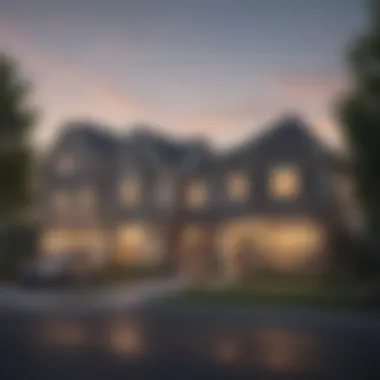
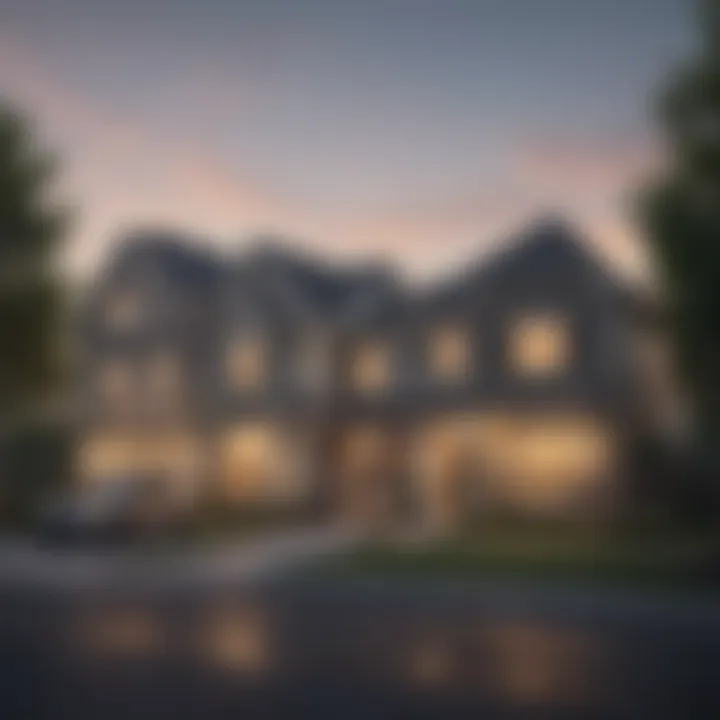
- Time Commitment: Regular maintenance tasks can be time-consuming. Homeowners should be prepared for ongoing repairs and seasonal upkeep tasks like gutter cleaning or lawn care.
- Financial Implications: Unplanned repairs can lead to financial strain. It's wise to create a maintenance budget to handle unexpected issues without significant stress.
- Flexibility: Homeowners have the freedom to choose service providers and schedule work as they see fit. This autonomy can be appealing but comes with the responsibility of finding reliable contractors.
"Homeownership is not just a financial investment; it's also an investment in time and effort."
Environmental Considerations
Environmental considerations are increasingly important in real estate discussions today. With climate change urgent, understanding how different housing types impact the environment is critical. Townhomes and traditional houses both offer unique opportunities for sustainability, but they differ substantially in their approach and effectiveness. Key factors to evaluate are energy efficiency, land use, and the community design surrounding these residential structures.
Sustainable Features of Townhomes
Townhomes often incorporate sustainable features more readily than traditional houses. Many townhome developments prioritize energy-efficient appliances, advanced insulation, and energy-saving windows. These elements contribute to lower energy consumption, which is beneficial for both the homeowner and the environment. Additionally, townhomes might feature shared resources, such as community gardens or shared green spaces.
Moreover, the typical density of townhome communities allows for reduced land consumption per dwelling unit. When land use is more efficient, it can lessen the overall ecological footprint. The architecture in many townhome designs also embraces modern, eco-friendly materials that not only enhance aesthetic appeal but also prioritize sustainability.
"Sustainable design in townhomes can lead to a 30% reduction in carbon footprint, significantly aiding in environmental conservation."
Green Building Practices in Houses
On the other hand, traditional houses have their own set of green building practices that can be quite remarkable. Many newer homes are being built with sustainable materials, incorporating solar panels and rainwater harvesting systems. By applying respected methods like the LEED (Leadership in Energy and Environmental Design) standards, builders are actively promoting energy efficiency and sustainability.
Curiously enough, traditional houses may be more customizable compared to townhomes. Homeowners have opportunities to design their own energy-saving systems or landscape features that conform to environmentally friendly practices. However, achieving such green distinctions can depend heavily on individual homeowners' commitments, which can make it a less predictable factor in environmental sustainability.
In summary, both townhomes and traditional houses have their merits and challenges in terms of environmental considerations. Selecting between the two may depend on individual preferences, community designs, and the extent to which sustainable features are prioritized by developers.
Future Trends in Housing
The tendency of urbanization is noticeably shaping future trends in the housing market. This section addresses various elements that are crucial in the evolution of both townhomes and traditional houses. Increasing demand for sustainable living, affordability in densely populated areas, and innovative designs play significant roles in how the future of housing is shaping up.
One primary consideration is the shift towards environmentally friendly construction. As awareness around climate change rises, developers and builders are looking to create homes with energy-efficient systems. This includes installing solar panels and utilizing energy-efficient appliances. Such advancements not only help the environment but also reduce monthly utility costs for homeowners.
Another trend is the increasing need for multi-functional spaces in homes. With remote work becoming more prevalent, potential buyers now seek layouts that can accommodate home offices, workout areas, and even learning spaces for children. Modern townhomes are evolving to incorporate these features seamlessly while maintaining their compact nature.
Benefits and implications of these trends are evident.
- Increased sustainability leads to lower operating costs for homeowners.
- Multi-functional spaces enhance living comfort and convenience.
- Urban developments prioritize mixed-use designs fostering community interactions.
Understanding these trends is vital for potential buyers and investors. Those who stay informed can make better decisions that align with their lifestyles and financial capacities.
"Focusing on future trends in housing offers insights that allow both builders and buyers to adapt to changing demands and preferences."
Innovation in Townhome Development
The arrival of innovation in townhome development is a crucial component of modern housing trends. Developers are experimenting with new materials and construction methods. This includes prefabricated components and modular designs that reduce building time and costs.
The emphasis on community and lifestyle is more evident in new townhome projects. Such developments often integrate shared amenities, like parks and co-working spaces, effectively fostering a sense of belonging among residents.
Incorporating smart home technology is another significant innovation. Many new townhomes are built to accommodate smart devices that facilitate energy management, security, and convenience. Future buyers are likely to prioritize these technological features in their purchasing decisions.
Evolving Designs in Traditional Houses
Evolving designs in traditional houses reflect changing tastes and demands among homebuyers. Shifts towards open floor plans that enhance natural light and encourage social interactions are common. This design trend breaks away from the segmented spaces typical of older homes.
Additionally, there is a notable emphasis on outdoor living spaces within traditional houses. Homebuyers are increasingly valuing features such as spacious decks, landscaped gardens, and outdoor kitchens. These elements elevate the living experience, facilitating a balance between indoor and outdoor environments.
Customization options are also expanding. Homebuyers now express interest in tailoring their living spaces to fit their personal styles. This involves options ranging from the configuration of living areas to choices in materials and finishes, providing a more personalized home experience.
In sum, the interplay between townhome development and traditional house design underscores significant shifts in housing trends. Staying abreast of these developments will inform potential buyers and homeowners about where to invest and how to adapt to these changes.
The End
In evaluating the differences between townhomes and traditional houses, it becomes essential to synthesize the various aspects discussed throughout this article. Understanding the nuances of each option plays a significant role in the decision-making processes for potential homeowners and real estate investors alike. This final section highlights critical elements, benefits, and considerations that could impact one's choice.
The financial implications present a pivotal area of focus. Townhomes often provide lower entry prices and potentially lower ongoing costs due to shared maintenance fees. Conversely, purchasing a traditional house can represent a larger financial commitment, but it also may yield increased long-term value and customization opportunities.
Beyond the financial aspect, lifestyle considerations must be recognized. Townhomes frequently foster a sense of community through their close-knit arrangements, which can appeal to those seeking social interactions more readily available in smaller developments. On the other hand, traditional houses typically offer greater privacy and assorted neighborhood dynamics that fluctuate with more diverse demographics.
The analysis presented in this article leads to important reflections. While townhomes offer compelling advantages in terms of affordability and community living, traditional houses often provide more space and independence. Therefore, understanding personal priorities, be it privacy, investment potential, or community, is crucial for anyone navigating these options.
"The choice between a townhome and a traditional house ultimately reflects individual preferences and financial capabilities."
In summary, the complexity of the housing market makes it imperative for prospective buyers to weigh these considerations carefully. As preferences vary broadly among different demographics, people must identify which elements resonate with their lifestyle and goals. This thoughtful exploration aids in achieving a satisfying homeownership experience, aligning personal aspirations with practical realities.















